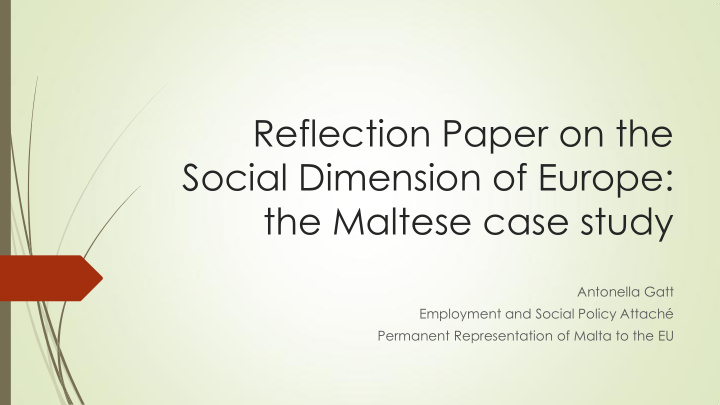



Reflection Paper on the Social Dimension of Europe: the Maltese case study Antonella Gatt Employment and Social Policy Attaché Permanent Representation of Malta to the EU
Content Social Dimension: The European context Social Dimension: The Maltese context The three options presented in the Reflection Paper on the Social Dimension vis-à-vis Malta
Social Dimension: The European context
The EU and its Social Dimension
The European Social Model “Huge challenges await us. It is up to us to shape these challenges. If we want a role to play in the future we have to play it now. It is up to us to ensure that the handwriting of the European Social Model is clearly visible in everything we do. Because Europe is the protective shield for all of us who can call this magnificent content their home.” Jean-Claude Juncker President of the European Commission Strasbourg, 22 October 2014
Social Dimension: The Maltese context
Malta and the Social Scoreboard Equal opportunities and access to the labour market: Female labour market participation : highest increase, widest gender employment gap People at risk of poverty or social exclusion : poverty and social exclusion risks are declining but substantial for children, the elderly and the low-skilled Education : increase in educational attainment, drop in Early School Leavers but still at a relatively high rate, share of 30 to 34 year olds with tertiary education increased continuously between 2008 – 2015
Malta and the Social Scoreboard Dynamic labour markets and fair working conditions: Labour force structure : increase in employment rate, decrease in unemployment rate, labour and skills shortage Social protection and inclusion: Healthcare : low share of the population cannot meet their medical needs Digital access : half the population have at least basic digital skills
Malta and the EU 2020 targets UNIT REFERENCE PERIOD TARGET TABLE 2008 2012 2013 2014 2015 2016 75% of the population aged 20-64 should be employed Employ ment % of rate - populati 59.2 63.1 64.8 66.4 67.8 69.6 70 age on aged group 20-64 20-64
Malta and the EU 2020 targets The share of early school leavers should be under 10% and at least 40% of 30-34 years old should have completed a tertiary or equivalent education Early leavers % of from population 27.2 21.1 20.5 20.3 (b) 19.8 19.7 10 education aged 18- and 24 training Tertiary % of educational population 21.0 24.9 26.0 26.5 (b) 27.8 29.9 33 attainment aged 30-34
National Practices Female labour market participation : free child care, breakfast clubs, Klabb 3 – 16, one year tax credit Inclusive labour market: quota for the employment of persons with disability, National Integration Strategy by end of 2017 Work-life balance : flexi-time and tele-working Poverty and Social Exclusion : tapering of benefits, in-work benefit, first-time buyer scheme Skills mismatch : Investing in Skills scheme, Training Pays scheme
The Maltese Presidency and the Social Dimension Legislative dossiers: Revision of Regulation 883, the European Accessibility Act, the Posting of Workers Directive, Carcinogens Directive Informal EPSCO Council: Making Work Pay Council Conclusions on Making Work Pay Council Conclusions on the Enhancing of Skills of women and men in the labour market The European Social Fund: Past, Present and Future Conference
Maltese characteristics and context Eurozone member Geographical location Strong economy Small public administration Skills shortage and human resources supply Brexit and potential upcoming relocations
The three options of the Reflection Paper on the Social Dimension of Europe
Option 1: Limiting the ‘Social Dimension’ to free movement Basic level of legislation Example of legislation that would apply: Posting of Workers Directive, Regulation 883/04, Recognition of Academic Qualifications, Patients’ Rights Directive. No exchange of best practices Less or no funding or co-funding
Option 2: Those who want to do more in the social field do more Eurozone Member States VS non-Eurozone Member states Enhanced co-operation Two-speed Europe Different players in the social field
Option 3: The EU-27 deepen the Social Dimension of Europe together Common social standards intertwined in the single market Revaluation of all four instruments: legislation, cooperation, guidance and funding. European Social Model VS European Social Models Beyond minimum standards, towards harmonisation The establishment of a European Social Standards Union Higher conditionality in terms of eligibility of EU funds
Moving forward Changing EU context Social considerations that go beyond the ‘classical’ social policy Social Summit for fair jobs and growth on 17 th November Different national backgrounds, same goal Common upcoming challenges, different potential approaches
Recommend
More recommend